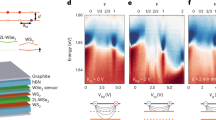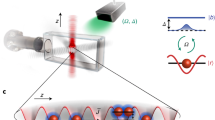Abstract
The effect of quantum statistics in quantum gases and liquids results in observable collective properties among many-particle systems. One prime example is Bose–Einstein condensation, whose onset in a quantum liquid leads to phenomena such as superfluidity and superconductivity. A Bose–Einstein condensate is generally defined as a macroscopic occupation of a single-particle quantum state, a phenomenon technically referred to as off-diagonal long-range order due to non-vanishing off-diagonal components of the single-particle density matrix1,2,3. The wavefunction of the condensate is an order parameter whose phase is essential in characterizing the coherence and superfluid phenomena4,5,6,7,8,9,10,11. The long-range spatial coherence leads to the existence of phase-locked multiple condensates in an array of superfluid helium12, superconducting Josephson junctions13,14,15 or atomic Bose–Einstein condensates15,16,17,18. Under certain circumstances, a quantum phase difference of π is predicted to develop among weakly coupled Josephson junctions19. Such a meta-stable π-state was discovered in a weak link of superfluid 3He, which is characterized by a ‘p-wave’ order parameter20. The possible existence of such a π-state in weakly coupled atomic Bose–Einstein condensates has also been proposed21, but remains undiscovered. Here we report the observation of spontaneous build-up of in-phase (‘zero-state’) and antiphase (‘π-state’) ‘superfluid’ states in a solid-state system; an array of exciton–polariton condensates connected by weak periodic potential barriers within a semiconductor microcavity. These in-phase and antiphase states reflect the band structure of the one-dimensional polariton array and the dynamic characteristics of metastable exciton–polariton condensates.
This is a preview of subscription content, access via your institution
Access options
Subscribe to this journal
Receive 51 print issues and online access
$199.00 per year
only $3.90 per issue
Buy this article
- Purchase on Springer Link
- Instant access to full article PDF
Prices may be subject to local taxes which are calculated during checkout




Similar content being viewed by others
References
Penrose, O. & Onsager, L. Bose-Einstein condensation and liquid helium. Phys. Rev. 104, 576–584 (1956)
Beliaev, S. T. Application of the methods of quantum field theory to a system of bosons. J. Exp. Theor. Phys. 34, 417–432 (1958)
Yang, C. N. Concept of off-diagonal long-range order and the quantum phases of liquid He and of superconductors. Rev. Mod. Phys. 34, 694–704 (1962)
Tilley, D. R. & Tilley, J. Superfluidity and Superconductivity Chs 1–3, and 7 (Adam Hilger, New York, 1990)
Pitaevskii, L. P. & Stringari, S. Bose-Einstein Condensation (Clarendon, Oxford, 2003)
Leggett, A. J. Quantum Liquids: Bose Condensation and Cooper Pairing in Condensed-matter Systems Chs 1–4 (Oxford Univ. Press, Oxford, 2006)
Andrews, M. R. et al. Observation of interference between two Bose condensates. Science 275, 637–641 (1997)
Hagley, E. W. et al. Measurement of the coherence of a Bose-Einstein condensate. Phys. Rev. Lett. 83, 3112–3115 (1999)
Bloch, I., Hansch, T. W. & Esslinger, T. Measurement of the spatial coherence of a trapped Bose gas at the phase transition. Nature 403, 166–170 (2000)
Castin, Y. & Dalibard, J. Relative phase of two Bose-Einstein condensates. Phys. Rev. A. 55, 4330–4337 (1997)
Naraschewski, M. & Glauber, R. J. Spatial coherence and density correlations of trapped Bose gases. Phys. Rev. A. 59, 4595–4607 (1999)
Davis, J. C. & Packard, R. E. Superfluid 3He Josephson weak links. Rev. Mod. Phys. 74, 741–773 (2002)
Hansen, J. B. & Lindelof, P. E. Static and dynamic interactions between Josephson junctions. Rev. Mod. Phys. 56, 431–459 (1984)
Hadley, P. M., Beasley, R. & Wiesenfeld, K. Phase locking of Josephson-junction series arrays. Phys. Rev. B 38, 8712–8719 (1988)
Cataliotti, F. S. et al. Josephson junction arrays with Bose-Einstein condensates. Science 293, 843–846 (2001)
Anderson, B. P. & Kasevich, M. A. Macroscopic quantum interference from atomic tunnel arrays. Science 282, 1686–1689 (1998)
Orzel, C. et al. Squeezed states in a Bose-Einstein condensate. Science 291, 2386–2389 (2001)
Greiner, M. et al. Quantum phase transition from a superfluid to a Mott insulator in a gas of ultracold atoms. Nature 415, 39–44 (2002)
Bulaevskii, L. N., Kuzii, V. V. & Sobyanin, A. A. Superconducting system with weak coupling to current in ground state. JETP Lett. 25, 290–294 (1977)
Backhaus, S. et al. Discovery of a metastable pi-state in a superfluid 3He weak link. Nature 392, 687–690 (1998)
Smerzi, A. et al. Quantum coherent atomic tunneling between two trapped Bose-Einstein condensates. Phys. Rev. Lett. 79, 4950–4953 (1997)
Weisbuch, C. et al. Observation of the coupled exciton-photon mode splitting in a semiconductor quantum microcavity. Phys. Rev. Lett. 69, 3314–3317 (1992)
Houdre, R. et al. Measurement of cavity-polariton dispersion curve from angle-resolved photoluminescence experiments. Phys. Rev. Lett. 73, 2043–2046 (1994)
Deng, H. et al. Polariton lasing versus photon lasing in a semiconductor microcavity. Proc. Natl Acad. Sci. USA 100, 15318–15323 (2003)
Deng, H. et al. Quantum degenerate exciton-polaritons in thermal equilibrium. Phys. Rev. Lett. 97, 146402 (2006)
Kasprzak, J. et al. Bose-Einstein condensation of exciton polaritons. Nature 443, 409–414 (2006)
Yeh, P. Optical Waves in Layered Media Ch. 5 (John Wiley, Hoboken, 2005)
Pedri, P. et al. Expansion of a coherent array of Bose-Einstein condensates. Phys. Rev. Lett. 87, 220401 (2001)
Madelung, O. Introduction to Solid-state Theory Ch. 2 (Springer, Berlin, 1996)
Acknowledgements
This work was supported by the JST/SORST programme and by Special Coordination Funds for Promoting Science and Technology in Japan. The high-quality microcavity cavity sample is courtesy of G. S. Solomon, R. Hey, K. Ploog and A. Forchel. We thank T. Maruyama for support and S. Sasaki for the device fabrication. C.W.L. thanks Y. R. Shen for comments and discussions.
Author information
Authors and Affiliations
Corresponding authors
Supplementary information
Supplementary Information
The file contains Supplementary Notes with Supplementary Figures S1-S6 and additional references. The document describes the signatures of exciton-polariton condensation without a periodically modulated potential, focusing on the spatial coherence properties and condensation in momentum space. The characteristics of the exciton-polariton condensate form the basis of the study of the exciton-polariton condensate array. We also discuss the diffraction patterns of ‘zero-state’ and ‘π-state’ considering the finite transmittance through the metallic strips and spatial coherence. A rate-equation model is used to describe the dynamics and evolution of the ‘zero-state’ and ‘π-state’ as a function of the pumping rate. (PDF 3416 kb)
Rights and permissions
About this article
Cite this article
Lai, C., Kim, N., Utsunomiya, S. et al. Coherent zero-state and π-state in an exciton–polariton condensate array. Nature 450, 529–532 (2007). https://doi.org/10.1038/nature06334
Received:
Accepted:
Issue Date:
DOI: https://doi.org/10.1038/nature06334
This article is cited by
-
Signature of spin-triplet exciton condensations in LaCoO3 at ultrahigh magnetic fields up to 600 T
Nature Communications (2023)
-
Non-equilibrium Bose–Einstein condensation in photonic systems
Nature Reviews Physics (2022)
-
Polariton condensates for classical and quantum computing
Nature Reviews Physics (2022)
-
Perovskite semiconductors for room-temperature exciton-polaritonics
Nature Materials (2021)
-
Tunable exciton-polaritons emerging from WS2 monolayer excitons in a photonic lattice at room temperature
Nature Communications (2021)
Comments
By submitting a comment you agree to abide by our Terms and Community Guidelines. If you find something abusive or that does not comply with our terms or guidelines please flag it as inappropriate.



